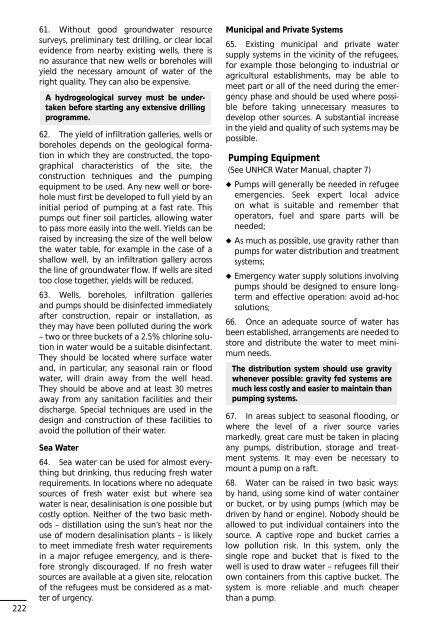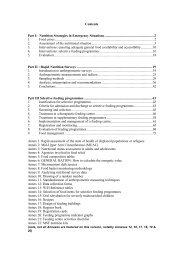UNHCR Handbook for Emergencies - UNHCR eCentre
UNHCR Handbook for Emergencies - UNHCR eCentre
UNHCR Handbook for Emergencies - UNHCR eCentre
Create successful ePaper yourself
Turn your PDF publications into a flip-book with our unique Google optimized e-Paper software.
222<br />
61. Without good groundwater resource<br />
surveys, preliminary test drilling, or clear local<br />
evidence from nearby existing wells, there is<br />
no assurance that new wells or boreholes will<br />
yield the necessary amount of water of the<br />
right quality. They can also be expensive.<br />
A hydrogeological survey must be undertaken<br />
be<strong>for</strong>e starting any extensive drilling<br />
programme.<br />
62. The yield of infiltration galleries, wells or<br />
boreholes depends on the geological <strong>for</strong>mation<br />
in which they are constructed, the topographical<br />
characteristics of the site, the<br />
construction techniques and the pumping<br />
equipment to be used. Any new well or borehole<br />
must first be developed to full yield by an<br />
initial period of pumping at a fast rate. This<br />
pumps out finer soil particles, allowing water<br />
to pass more easily into the well. Yields can be<br />
raised by increasing the size of the well below<br />
the water table, <strong>for</strong> example in the case of a<br />
shallow well, by an infiltration gallery across<br />
the line of groundwater flow. If wells are sited<br />
too close together, yields will be reduced.<br />
63. Wells, boreholes, infiltration galleries<br />
and pumps should be disinfected immediately<br />
after construction, repair or installation, as<br />
they may have been polluted during the work<br />
– two or three buckets of a 2.5% chlorine solution<br />
in water would be a suitable disinfectant.<br />
They should be located where surface water<br />
and, in particular, any seasonal rain or flood<br />
water, will drain away from the well head.<br />
They should be above and at least 30 metres<br />
away from any sanitation facilities and their<br />
discharge. Special techniques are used in the<br />
design and construction of these facilities to<br />
avoid the pollution of their water.<br />
Sea Water<br />
64. Sea water can be used <strong>for</strong> almost everything<br />
but drinking, thus reducing fresh water<br />
requirements. In locations where no adequate<br />
sources of fresh water exist but where sea<br />
water is near, desalinisation is one possible but<br />
costly option. Neither of the two basic methods<br />
– distillation using the sun’s heat nor the<br />
use of modern desalinisation plants – is likely<br />
to meet immediate fresh water requirements<br />
in a major refugee emergency, and is there<strong>for</strong>e<br />
strongly discouraged. If no fresh water<br />
sources are available at a given site, relocation<br />
of the refugees must be considered as a matter<br />
of urgency.<br />
Municipal and Private Systems<br />
65. Existing municipal and private water<br />
supply systems in the vicinity of the refugees,<br />
<strong>for</strong> example those belonging to industrial or<br />
agricultural establishments, may be able to<br />
meet part or all of the need during the emergency<br />
phase and should be used where possible<br />
be<strong>for</strong>e taking unnecessary measures to<br />
develop other sources. A substantial increase<br />
in the yield and quality of such systems may be<br />
possible.<br />
Pumping Equipment<br />
(See <strong>UNHCR</strong> Water Manual, chapter 7)<br />
◆ Pumps will generally be needed in refugee<br />
emergencies. Seek expert local advice<br />
on what is suitable and remember that<br />
operators, fuel and spare parts will be<br />
needed;<br />
◆ As much as possible, use gravity rather than<br />
pumps <strong>for</strong> water distribution and treatment<br />
systems;<br />
◆ Emergency water supply solutions involving<br />
pumps should be designed to ensure longterm<br />
and effective operation: avoid ad-hoc<br />
solutions;<br />
66. Once an adequate source of water has<br />
been established, arrangements are needed to<br />
store and distribute the water to meet minimum<br />
needs.<br />
The distribution system should use gravity<br />
whenever possible: gravity fed systems are<br />
much less costly and easier to maintain than<br />
pumping systems.<br />
67. In areas subject to seasonal flooding, or<br />
where the level of a river source varies<br />
markedly, great care must be taken in placing<br />
any pumps, distribution, storage and treatment<br />
systems. It may even be necessary to<br />
mount a pump on a raft.<br />
68. Water can be raised in two basic ways:<br />
by hand, using some kind of water container<br />
or bucket, or by using pumps (which may be<br />
driven by hand or engine). Nobody should be<br />
allowed to put individual containers into the<br />
source. A captive rope and bucket carries a<br />
low pollution risk. In this system, only the<br />
single rope and bucket that is fixed to the<br />
well is used to draw water – refugees fill their<br />
own containers from this captive bucket. The<br />
system is more reliable and much cheaper<br />
than a pump.



